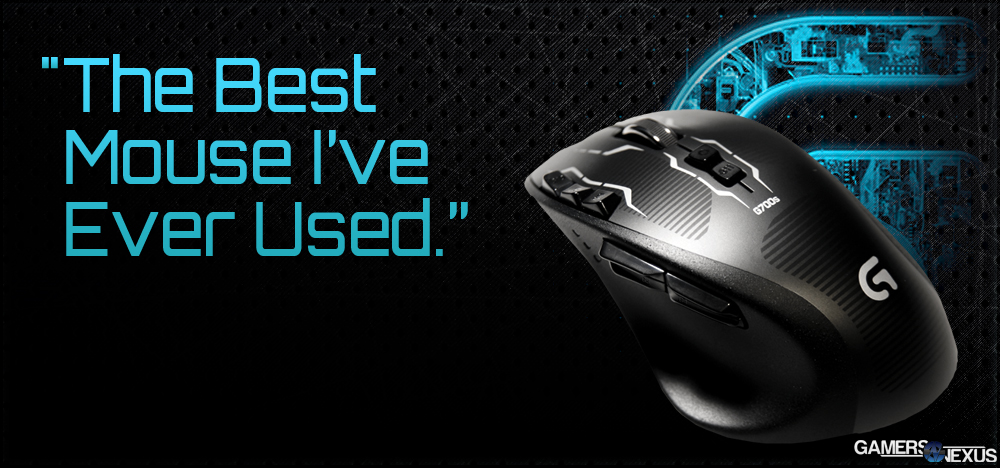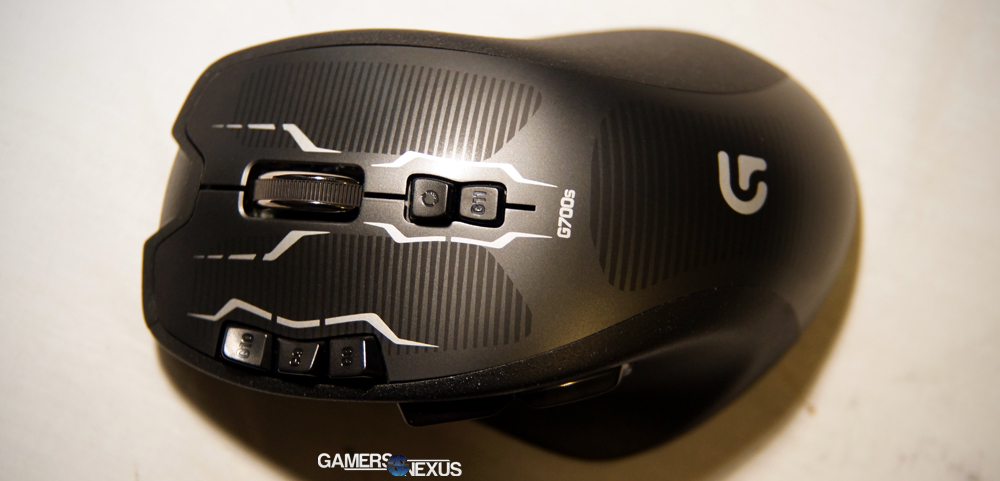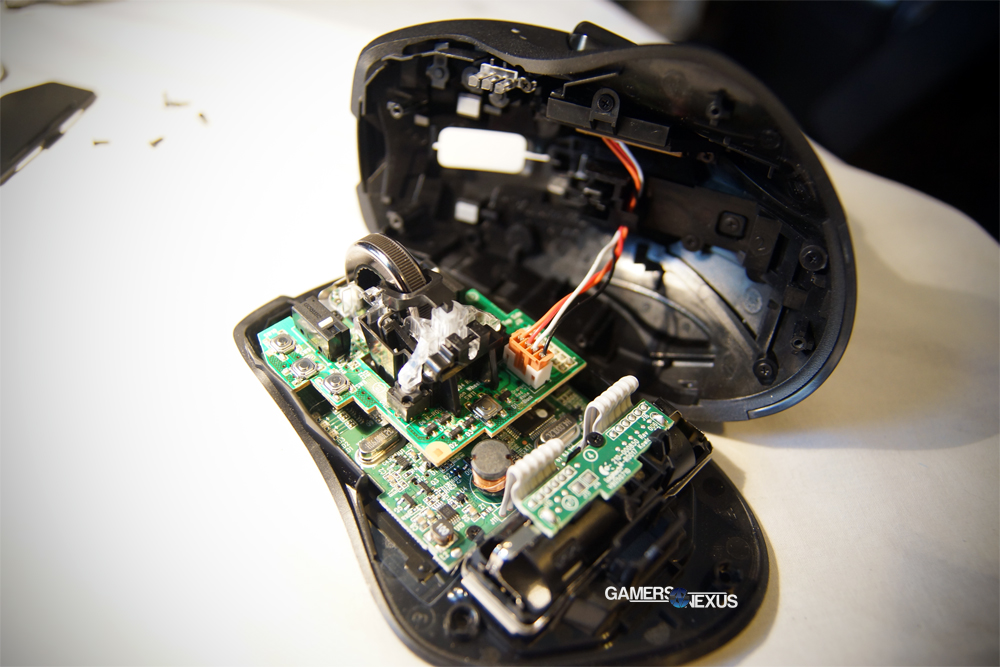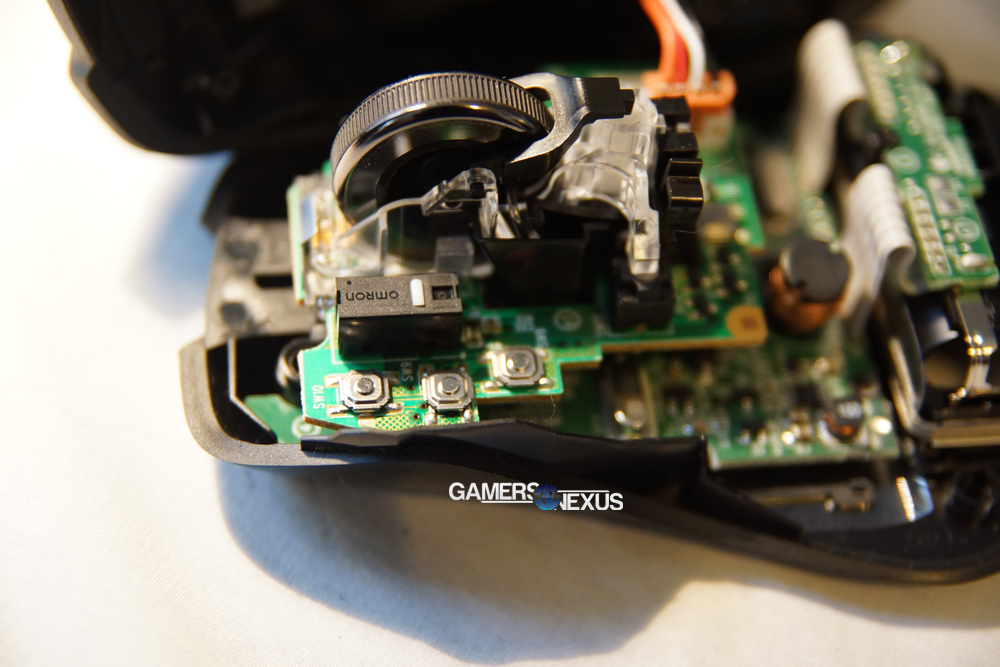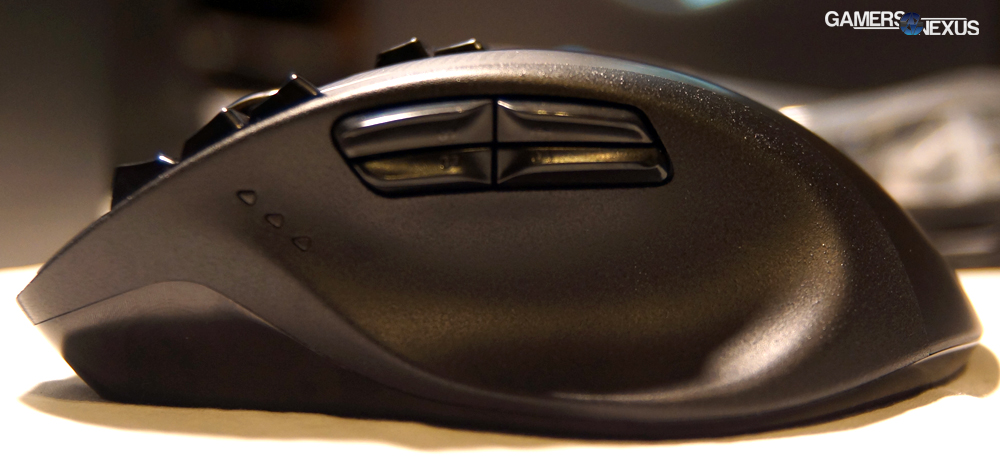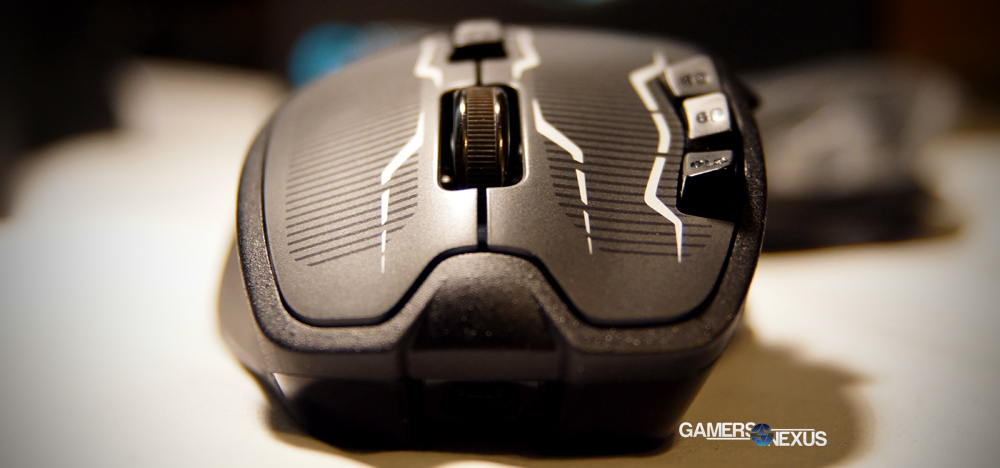Gaming peripherals are currently spearheading our efforts to deconstruct the underlying components within gaming hardware and, following our Genius Gila review, today we look at Logitech's new G700s mouse. We first spoiled Logitech's new gaming peripherals right before PAX East, where we covered hard specs and talked a bit about Logitech's new branding, but have since had time to speak with Logitech engineers and play with the hardware.
The G700s and G500s were what specifically interested our review staff (Patrick Lathan will be looking at the G500s) for their one-two punch in the high-end and mid-range gaming markets, respectively; a review is also pending for the new keyboards and a headset, though that's still slightly in the distance.
Though GN's staff has worked with Logitech's recent G600 MMO mouse, I haven't personally gotten much hands-on time with anything by Logitech since the G5 (which still works, I'll 'mind you, and damn well). Gripping the G700s after using the Gila, DeathTaker, and Tt Level 10 has felt something like a homecoming; I've had a long history with Logitech mice—the MX518 and G5 being most prominent—and I've seen the company's serious flaws and feats over the last decade or so. Let's see how the G700s lives up to the legacy, and if it's made any noteworthy improvements over the issues found in previous mice.
In this Logitech G700s mouse review, we'll look at specs, tear-down to the internals, discuss sensor tech, and talk about Logitech's approach to engineering.
Logitech G700s Gaming Mouse Specs
| Model | Logitech G700s M-R0017 |
| Interface | Wireless (2.4GHz) ~30ft. Wired (micro-USB) |
| Sensor | Avago ADNS 9808 |
| Laser Resolution | 200-8200DPI |
| Profile Support | 5 Profiles through software |
| Buttons | 13 total buttons |
| Power | USB or battery (1xAA) |
| Features | Hydrophobic rubberized grip Hyper-scroll wheel |
| MSRP | $100 on TigerDirect |
Logitech G700s Video Review
Logitech G700s Features & Internals / Tear-Down
As I've stated innumerably in the past, we'll hit the hard specifications before getting into my own opinions and use case scenarios / testing.
Most immediately noted, the G700s offers both wired and wireless capabilities, with wireless running on a rechargeable battery (included). The mouse ships with a tiny USB RF receiver that interfaces with the device, but a standard Micro USB cable can connect for wired functionality. To that end, included with the G700s is a specially-molded G700s Micro USB cable (6ft with additional extender cable) that'll fit the unique shape of the G700s' 'mouth,' but isn't required beyond its aesthetic purposes.
And of course, any modern gaming mouse needs to be aggressively outfitted with buttons -- ideally the same amount of buttons as found on a keyboard, so we can eliminate the need for one -- and the G700s complies. Without being as superfluous as the G600, the G700s mouse is advertised as having 13 buttons: Left-mouse (LMB), right-mouse (RMB), middle-mouse (MMB), 4 thumb-position buttons (left side - standard m4/m5 location), 3 additional index-finger buttons, 2 buttons south of the wheel, and then the wheel itself can press both down and side-to-side. One of the two centrally-located buttons controls the scroll wheel and cannot be reprogrammed. You'll find a video overview of the key-mapping software below.
Scroll wheels aren't something we normally spend much time on, but this one's worth mentioning: The G700s makes use of Logitech's "Hyper-Fast" wheel design, built on a MicroGear Precision scroll wheel that uses a ratcheted freehub design. Similar to freehub bike wheels, the objective is to enable fast, low-friction free-spinning with minimal energy input, but still offer (via toggle) standard 'clicky' scrolling. The main idea here is that you could set the wheel into motion, allow it to spin, then stop the wheel once you're at the point on the page where you need to be. This is primarily useful for paging through large documents and spreadsheets, where using the scrollbar isn't necessarily as accurate or quick as manually scrolling.
Found south of the scroll wheel is the noted toggle switch. Releasing the toggle activates the freespinning, pressing it makes for a normal ratcheted motion.
Logitech G700s Components Tear-Down
As we like to do with most products we review, we tore-down the G700s and checked-out the internals.
The mouse uses four separate PCBs -- one that interfaces for the four left-panel buttons, one for the charging and power circuit, one for the primary logic functions (including the sensor and Flash module), and then one that's fitted with the switch tech and scroll wheel. As irrelevant as internals may seem to everyday use, they actually tell us all about the product's reliability, endurance (by virtue of judging switch and button durability, supplied caps, etc.), and the overall quality going forward.
Mouse switches are generally a prominently-displayed indicator of the component quality: In previous mice we've torn apart, including the Genius mice, we've been met by cheap plastic switches (T-MEC supplied) for the ancillary buttons, but the G700s uses higher-endurance metal switches that should prove more responsive for long-term use. All this in mind, it's generally the buttons that fail before switches fail -- switches are often rated for far more clicks than the actual external buttons are, but it's still an important measurement of quality. Logitech is one of the few manufacturers outfitted with its own reliability engineering test lab (in Switzerland, no less) and assures us that their mice are rigorously tested for, in the case of the G700s, 20 million clicks.
Industry-standard Omron switches are used for LMB/RMB. Nothing fancy to speak of on that front.
Further on quality, upon disassembly we're met with the same high-quality capacitors found in other mice (with a pretty leak-resilient-looking seal) and a massive inductor (probably to help regulate the battery functions, like recharging).
Logitech is sticking with Avago's ADNS-9800 series sensor in their G700s mouse, similar to revs found in the Gila and G600, but they've iterated on the design (9808) to improve DPI stepping and framerate. The sensor is capable of delivering 200-8200DPI, though it's been a long, long time since maximum DPI has been relevant to gamers; there's only so much you can do with that sensitivity before it becomes uncontrollable. I found myself sitting at around 3100 DPI when playing Shootmania: Storm and Rift.
We asked Logitech Senior Product Manager Chris Pate—a veteran with the company since 1996—about sensor tech and its advancements. The first question seemed obvious: Is sensor tech a 'known-science' at this point, or is it still advancing? Is DPI overinflated in marketing materials? Here was his answer:
High DPI values were great when standard mice capped-out at 400 [DPI] and you wanted to run a 1280x1024 setup, but screen resolutions haven't even remotely kept pace with sensor capabilities. As it stands, our previous-generation 5700 DPI sensors are capable of traveling from the far left to the far right of a three-monitor 1080p setup with one inch of physical movement [...] We've found that the vast majority of gamers actually use 2500 DPI or lower.
While this may seem to suggest that updating our G500s and G700s to sensors that max-out at 8200 DPI is unnecessary, we evaluated this new sensor on a number of different parameters - including things like surface coverage and overall accuracy - and found that the new version was measurably better than the previous one.
The full interview will be published in a future article, but that should give a bit of background as to why we continue to see sensor advancements, despite seeming superfluous at times.
Logitech G700s Drivers / Software
Here's a video we produced for the G600 that details Logitech's software:
Quick note: I found the software to be incredibly buggy with the G700s. There was sporadic unresponsiveness and crashing that generally seemed to align with when the mouse was turned on/off throughout the day. These issues were resolved by terminating the task in task manager and re-launching it, and while annoying, were survivable and not all that much of an issue once I'd finalized the mouse configuration.
Logitech G700s Impressions: Grip, Aesthetics, Button-Placement
Externally, the mouse furthers its distance from competition with a unique, hand-friendly shape. The mouse itself sort of drifts wide to the right, making for a rounded extrusion for the holder's palm and pinky finger. Opposite this is an inward depression for the thumb, below which extrudes a 'wing' to rest it upon (meaning your thumb has a natural place to rest, but is still in a firm grip position). As long as you're using your right hand, the buttons are all within reaching distance and don't require overextension, making for a better gaming experience.
Speaking to materials for a moment, Logitech's made a bit of a fanfare about their "hydrophobic grip" and other surface materials. The mouse uses a hard, rubberized material on the left and right flanks -- it's bumpy and grippy, almost resembling a less abrasive griptape -- and makes for easy control. As 'hydrophobic' suggests, the material sort of repels liquid (like sweat or grease, in case you're gaming while eating bacon in the summer) and improves overall hand-to-mouse traction. The matte paint and surface material selected for the top of the mouse doesn't show fingerprints, so that's another plus on the materials front.
Finger positioning seems good, though it obviously varies heavily based on your hand/grip type. I found all the buttons to be easily reached while gaming and easily utilized -- there's a good number of options, but it's not overwhelming like the G600 sometimes feels. The three additional index buttons are flared-up in a manner that makes them unmistakable and easy to find, hopefully aiding in those tense MMO combat situations.
Logitech G700s Ergonomics & Overall Feel
Grip is the most important aspect of any mouse. When you're using any device for several hours a day, RSI (repetitive strain injury) becomes a real possibility that can have painful consequences. I can't speak for anyone else's wrist or ergonomics needs, but as a user with wrist pain in a computing environment (a result of many years of gaming), I've always been careful in mouse selection and ergonomics.
Moving from the Gila—which had serious grip issues—over to the G700s made it clear that Logitech knows what they're doing; I've always vouched for the G5 as being one of the most RSI-friendly mice on the market, even if it's not still the best mouse out there specifications-wise. When we met with Logitech at PAX East, they were quick to tell us that the company avoids the word "ergonomics" for legal reasons, which makes sense, but they were equally quick to state that experts are on-staff to design mice specifically with comfortable grip in-mind.
For our readers who suffer from similar pain problems as I do, here's what my symptoms of poor mouse design normally are: Pain in the tendons, normally pinky/ring, and pain in the wrist become more apparent -- the tendon pain is more noticeable and feels strained (RSI) and under tension when the hand is positioned awkwardly. The Gila provoked these issues after extended use (6+ hours), and while it's a great mouse aside from this, I personally can't use it for that reason. The G700s uses more natural and hand-friendly curves and fits well under the hand, but remains narrow enough that it doesn't awkwardly strain anything.
Personally, it's one of the most comfortable mice I've used since the G5, though I did find the G600 to have excellent grip as well.
G700s Battery Life, Wireless Range, Button Quality
In testing, we found the mouse's wireless function to operate perfectly at 20ft., making it decent for living room or bedroom use if you've got a wall-mounted display. Any farther than that pushes the limits, though I can't imagine many use cases where you'd be 30+ft away from a display.
Logitech's G-Series software offers three power saving settings for the G700s: Maximum power, "normal" power, and power saver. From what we understand, the modes largely just dictate when the mouse sleeps and wakes.
I tested the battery life with a mix of gaming and "everyday use" on the "maximum gaming" power configuration at 3200 DPI. The mouse was turned off whenever I stepped away from the computer, so this was testing pure longevity of the battery without entering sleep states as often as 'power saver' might. Presumably it does some sort of micro-/stutter-sleep when in use, like when you stop using the mouse for a minute. Because I didn't use the mouse constantly until it died, the battery life should provide a more realistic example of what to expect; constant use will drain the battery faster due to heat, so this loosely-structured test didn't account for constant usage until depletion.
I found that the battery persisted for approximately 18 hours, about 9 of which were gaming (including menu screens, respawn waits, and load screens, where the mouse occasionally entered sleep states). Logitech's site rates the mouse as having "up to 10 hours" of continuous-use battery life.
Logitech G700s: Final Thoughts & Conclusion
This has easily been the most extensive mouse review we've done yet, but I think it's justified: We've had the excellent opportunity to explore more of the tech driving a high-end mouse, talk about sensors, and hopefully give some solid background that can help fuel purchasing decisions.
I'm not a fan of hyperbole, so I'm serious when I say that the G700s is the best mouse I've ever used, period. Aside from the driver issues, the mouse is responsive in both wired and wireless modes, it's customizable, the grip is phenomenal, and the engineering is solid. Buying a $100 mouse won't make you good at games, but it certainly offers competitive players a bit more functionality without being overbearing, and the ergonomics are good enough to consider a purchase for RSI-inflicted users.
The only obstacle here is that the mouse is $100 -- and I'm not saying that the price is unfair, just that it's tough to justify considering that's 75% the cost of a mid-range GPU. If $100 is too much, and it may well be too expensive, consider looking into the G500s or G400s Logitech mice instead. Steel Series, Corsair, Thermaltake, and Genius all make competitively-priced gaming mice in the $50-$65 range, if you're not a fan of Logitech's cheaper options.
Let us know if you have questions.
- Steve "Lelldorianx" Burke.
